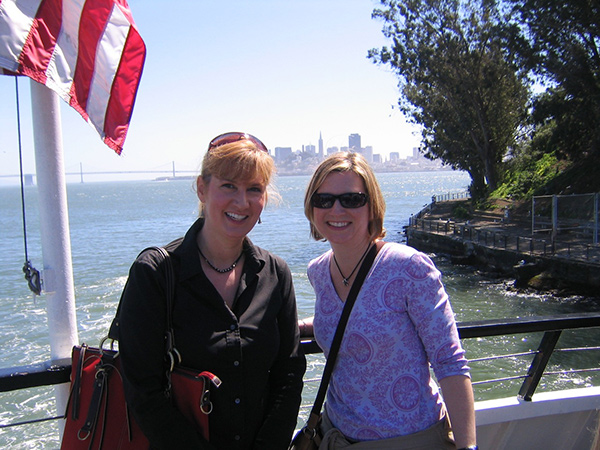In Praise of Partnership
During my drive to the office this morning, I learned that three American scientists have collectively demystified how it is that cells transport tiny, yet wildly influential, molecules within and among themselves.
The cell, it appears, is akin to “a large and busy port” where it is vitally urgent that certain molecular packages—containing cargo such as hormones or neurotransmitters—are delivered to the correct location at the precise millisecond when they are needed. Imagine FedEx perfected by microscopic robots.
It took three researchers to unpack the different components of this system, which involves an exquisitely calibrated relationship among genes, proteins, and calcium ions. James Rothman, Randy Schekman, and Thomas Südhof have been awarded the 2013 Nobel Prize in Physiology or Medicine “for their discoveries of machinery regulating vesicle traffic, a major transport system in our cells,” according to the Karolinska Institute. Because this machinery drives a number of important processes in our bodies, understanding how it works—and what can happen when it doesn’t—has major implications for the treatment of diseases, from neurological disorders to diabetes.
It is not surprising that such an intricate process would require more than one scientist to unravel it. The three Nobel recipients approached the puzzle from different directions, each bringing his own particular piece of expertise. By applying their corresponding strengths, they were able to put the pieces together and unveil a complex system fundamental to cellular organization.
I couldn’t help but note that one of these researchers is from the University of California, Berkeley, and another is from Stanford University—a pair of institutions coincidentally mentioned in this issue of Emory Magazine as an example of successful collaboration between a public and a private research university.
Our cover story on the longstanding partnership between Emory and the Georgia Institute of Technology celebrates exactly the sort of joint research and discovery efforts that were rewarded today by the Nobel Assembly. What makes such scientific collaboration thrive, according to President James Wagner and Georgia Tech President Bud Peterson, is a deliberate and sustained focus on complementary strengths. Promoting multiple, balanced specialties and perspectives creates synergy between individual research faculty, among academic groups and centers, and between the institutions themselves.
For Emory and Georgia Tech, the positive results are too numerous and wide-ranging to name, although we showcase a few in the pages to follow—including shared inventions, discoveries, grants, start-up companies, and a combined economic impact of more than $8 billion for Atlanta and Georgia. Many of those outcomes, Wagner says, would not be possible without partnership.
On a more personal level, it’s interesting to think that most of us probably have relationships with people who are markedly different from us, whether by fate or choice. We turn to friends who help us see our problems in a new way, coworkers who offer ideas we would never have dreamed up, siblings who counterbalance our talents and flaws with theirs. Many of us may have—even unknowingly—gravitated toward a spouse or partner whose personality traits complement, rather than mirror, our own. I can say from experience that the resulting tension is far outweighed by the benefits.

Mary Loftus and Paige Parvin 96G
For thirteen years, Associate Editor Mary Loftus and I have enjoyed a rich, lively, and harmonious working relationship at Emory Magazine. From the time we arrived within weeks of one another, we found much in common, spending hours over coffee talking about our kids, books, politics, relationships, our kids again, and always, whatever magazine stories were in the works. We’ve shared some memorable experiences in pursuit of those stories—like driving our teenagers to Memphis to see Graceland, taking a boat to Alcatraz (see photo), openly competing for the attention of Salman Rushdie at a cocktail reception, spending a night in a Boston emergency room, and (a personal favorite) showing up at a Hollywood party carrying shopping bags and wearing clothes we had literally, desperately, just bought at a Banana Republic when we realized that there was no way we would make it back to our hotel in time to change and there was no way we were missing what was almost certainly the only Hollywood party we would ever get to attend.
For all we’ve shared, I think our work together has probably benefited even more from what we don’t share. Mary’s workspace is an explosion of color and clutter; mine is (most of the time) neat and serene. Her interviews with subjects are open-ended conversations; mine are guided by a prepared script of questions. When we co-present at professional conferences, Mary prefers to leave room for spontaneity, while I insist on rehearsing every word. Mary is a naturally curious, meandering, big-picture thinker; I tend to steer us toward concrete implementation and attention to detail. Our styles reflect the different and, yes, complementary qualities we have brought to the magazine.
By the time this issue reaches you, Mary will have packed up her clutter and installed it in another office, just a few yards away in Emory’s Health Sciences Publications. I am delighted that she has taken on a promising new challenge. I’m also glad she’s not going far. Like a lot of lasting, productive partnerships, ours is much too valuable to leave behind.





